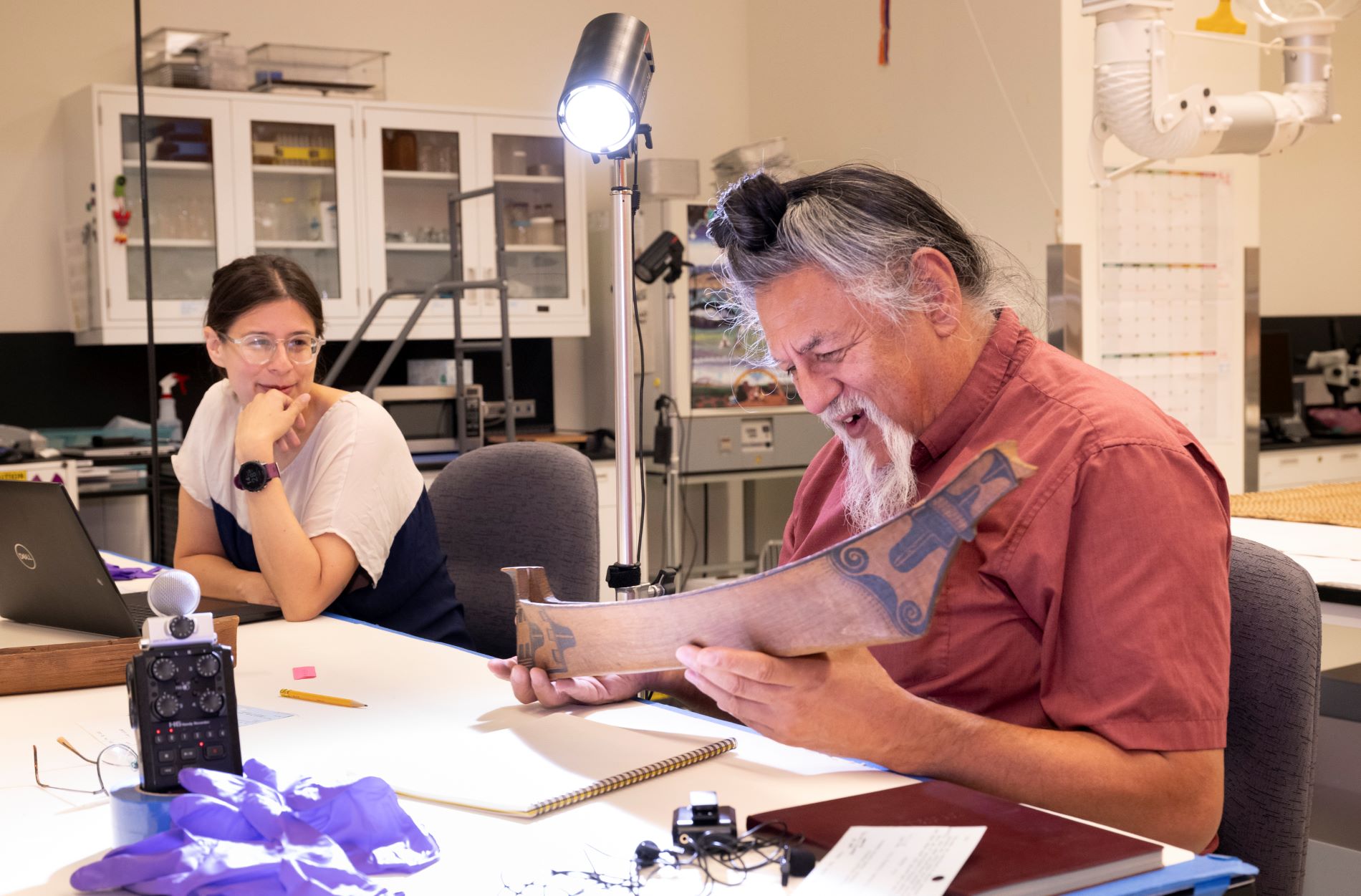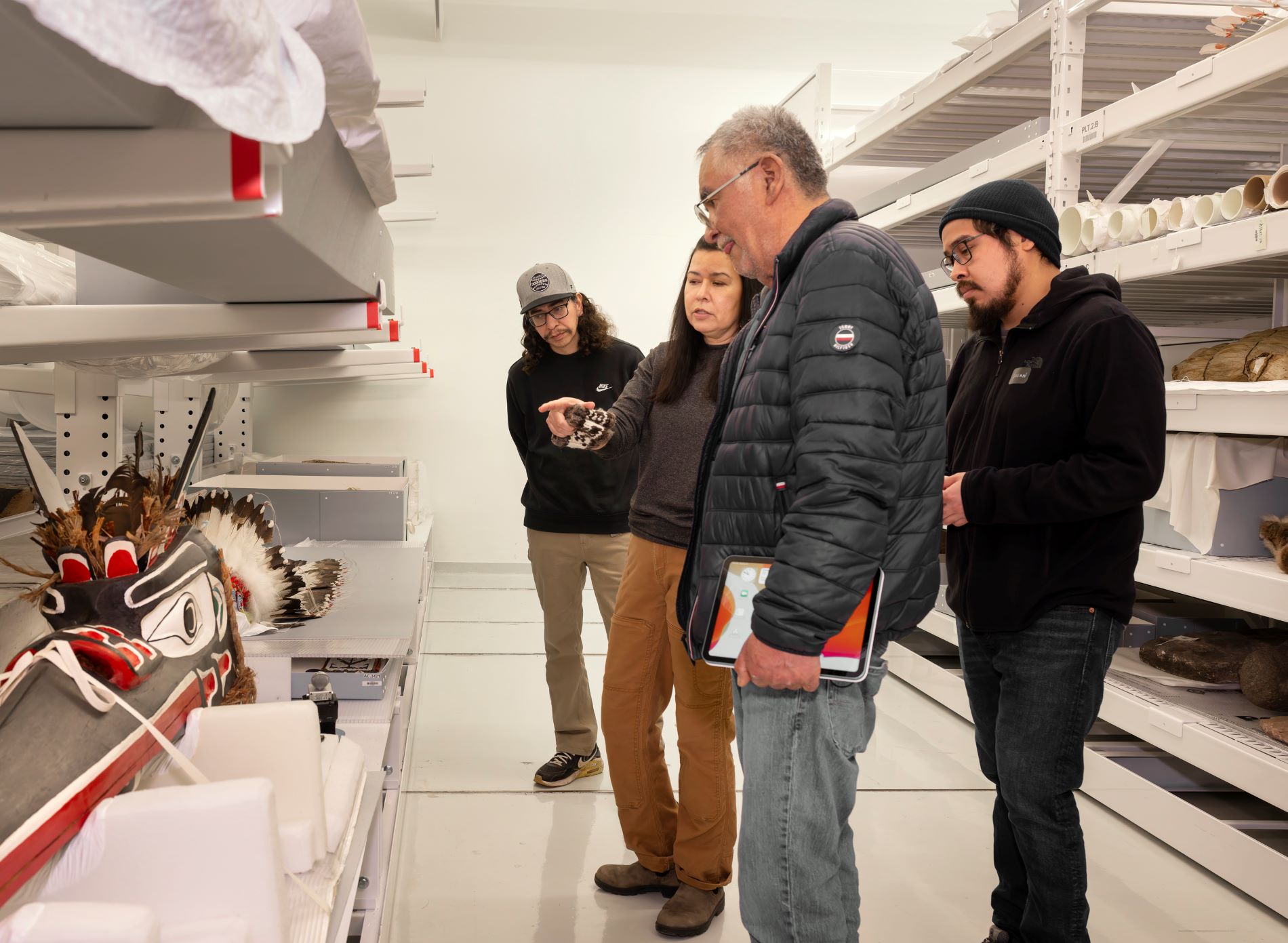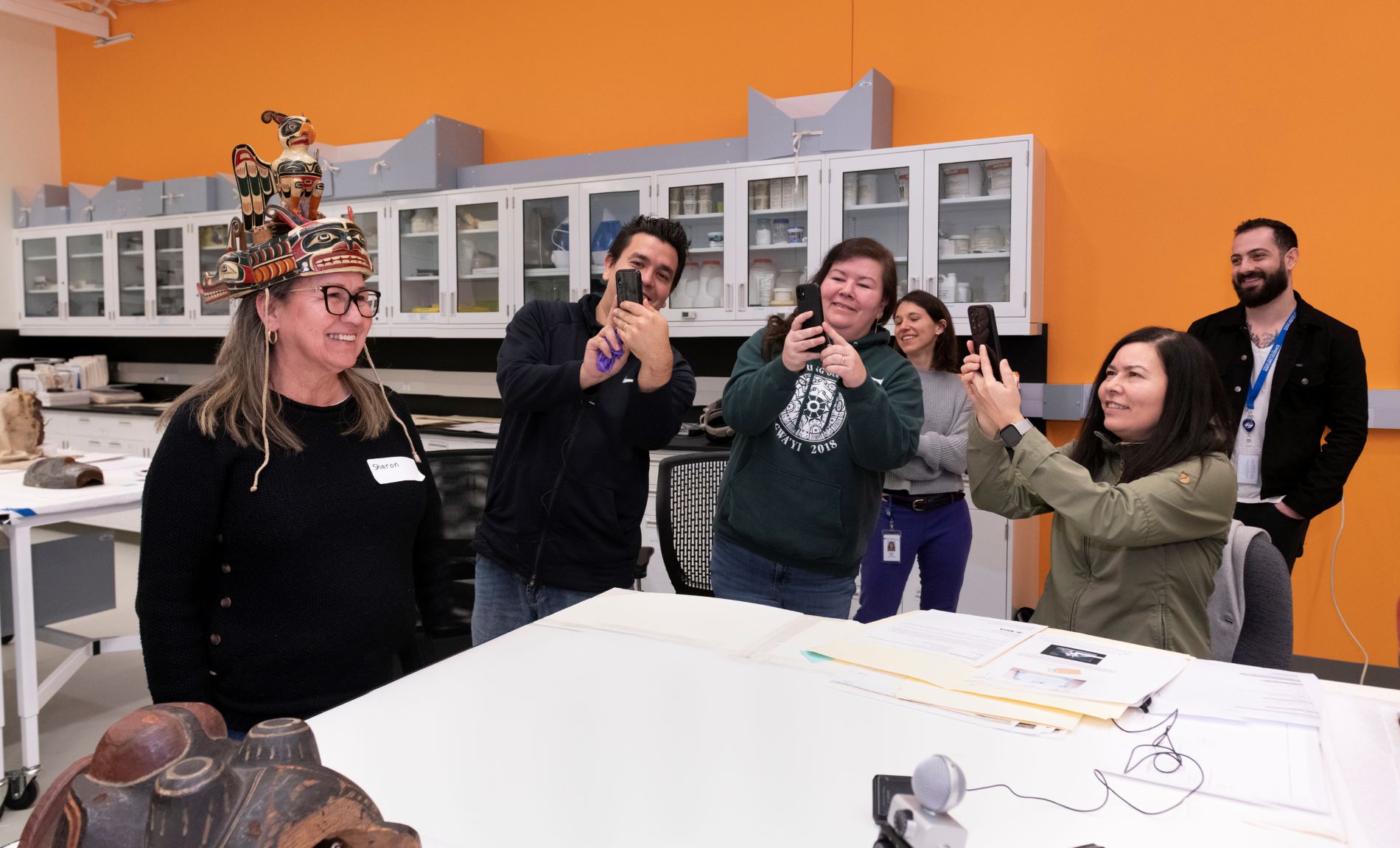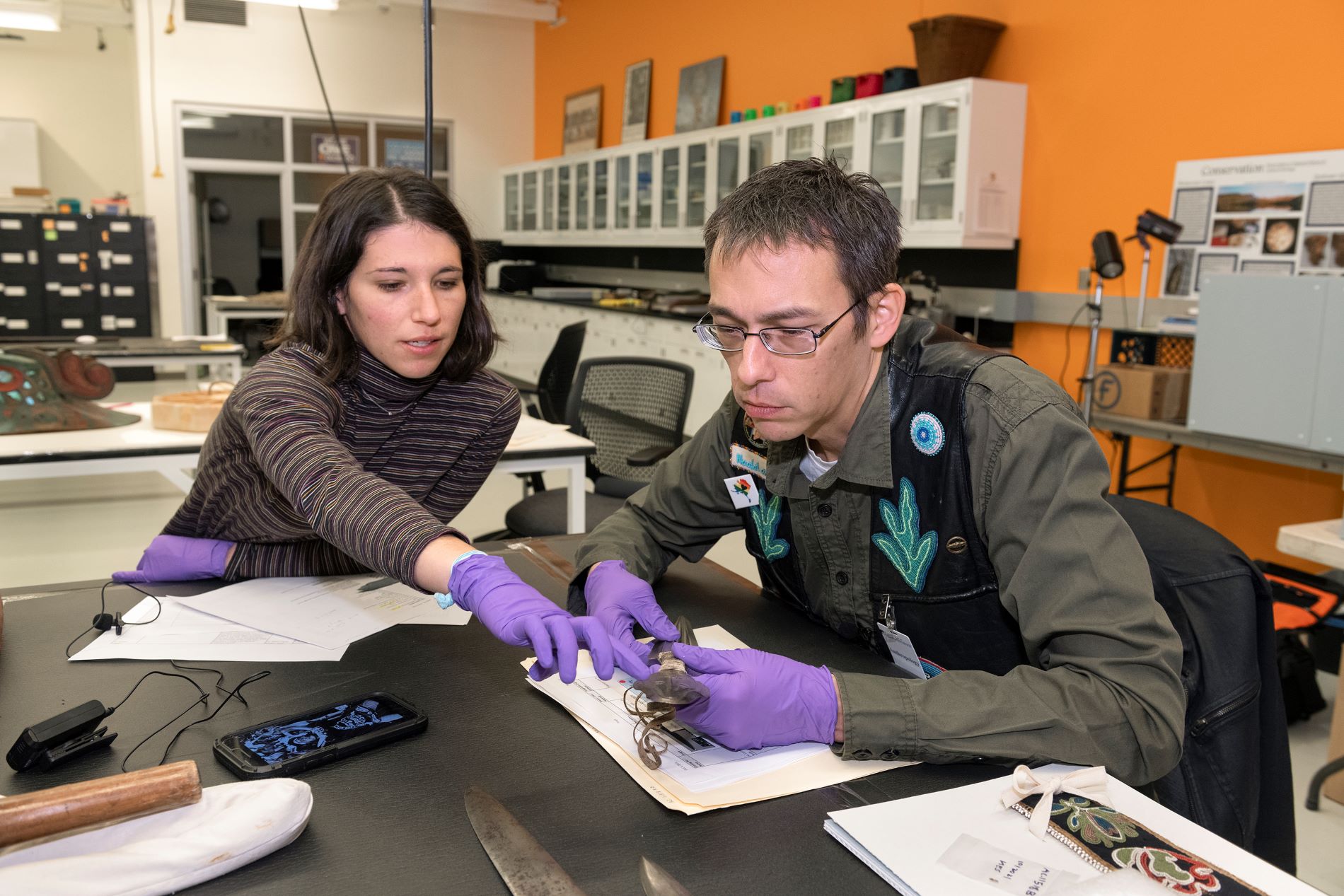Collaborative Conservation Grant Wraps up this Summer

For the past four years, the Museum has forged meaningful connections with Indigenous communities of the Northwest Pacific Coast through the collaborative conservation initiative titled “Northwest Coast Collections: Building Bridges and Detailed Conservation Survey.” Funded by the Institute of Museum and Library Services (MA-245839-OMS-20) in 2020 with additional support from the Avenir Conservation Center, this project welcomed over 20 Indigenous representatives from five North American Tribes and First Nations to the Denver Museum of Nature & Science.
This project had two main goals: assessing and understanding the conservation needs of the collection and doing this in partnership with members of originating and descendent communities. Building strong and lasting relationships with these communities whose collections we steward was a top priority.

Kwakwaka’wakw representatives, left to right, Brandon Willie, Marianne Nicolson, Willie Moon and Logan Willie examine a headdress carved by Willie’s father, Peter Moon in March, 2024. (Photo/ Rick Wicker)
This project provided the first opportunity for many Indigenous representatives to view and handle belongings from their community in the Museum’s collection. In some cases, the items were carved, painted or sewn by the parents of the visitors. Feedback from our collaborators has reinforced to us that we are stewards, not owners, of these items.
Culturally inclusive conservation expands what we consider to be care. Historically, conservation treatments focused on maintaining stable environmental storage conditions and using reversible or re-treatable materials to repair damage. Through our work on this grant, we have understood that the return of belongings to their originating communities is another way to care for these items. Thus, returning belongings has become a standard part of conservation conversations.

Kwakwaka’wakw representatives, from left to right, Ryan Nicolson, Midori Nicolson and Marianne Nicolson take photos of Sharon Gordon wearing a headdress that was carved for her great-great-grandfather Johnny Scow. Objects Conservator Megan Salas and Curator Chris Patrello look on in the background. (Photo/ Rick Wicker)
One of the priorities of this grant was to build relationships between the Museum and cultural knowledge keepers; we are eager to continue to work with them, as well as with partners from other communities. As our grant deadline approaches, we believe that the collaboration and discussion we developed with this grant should not end anytime soon.

Collaborator from Haida Gwaii Aay Aay Gidins examines argillite carvings at the Denver Museum of Nature & Science in April, 2022. (Photo/ Rick Wicker)
 “It’s important for us to be a part of the decision making, because [the items] belong to the people. Though they are ‘cared for’ in your museum, we believe we should still have ownership of the piece," said Research and Repatriation Coordinator at the Haida Gwaii Museum Aay Aay Gidins on his experience at the Museum.
“It’s important for us to be a part of the decision making, because [the items] belong to the people. Though they are ‘cared for’ in your museum, we believe we should still have ownership of the piece," said Research and Repatriation Coordinator at the Haida Gwaii Museum Aay Aay Gidins on his experience at the Museum.
 The need for community to connect to their belongings is at the center of how Naakil.aan Hans Chester sees future work with the Museum.
The need for community to connect to their belongings is at the center of how Naakil.aan Hans Chester sees future work with the Museum.

Tlingit representative Naakil.aan Hans Chester and Objects Conservator Megan Salas examine a steel dagger as part of the grant in March, 2022. (Photo/ Rick Wicker)
“The desire for DMNS to continue this process of collaboration with our communities after the grant ends is promising, as we wish to reconnect, and possibly reunite, with our objects and ancestors. It gives me hope that these precious objects and ancestors will one day make their way back to their original owners.” – Naakil.aan Hans Chester
 “All of the items I looked [at] and handled have special meaning to me. Each of these items took time out of someone’s life to design and create. Each was, at one time, a meaningful part of someone’s, some family’s or even some whole community’s life. Each still carries residue from their creators and their owners. When I handle such items, I feel like I am touching them and they are also touching me; that is, that they are alive and have agency. Of course, as a lifelong ritualist, as a dancer, as a carver, as a Speaker, as a historian, as a poet, as a relative to the creators and owners of the ceremonial and ritual treasures in Your care, and as the Head of my House, I am deeply moved by the hugely important silent, yet interrupted, conversation each of these treasures is a part of. That is, I see all of these treasures moving, in use, as they were meant to be seen by their owners and creators. Many times, during our work in Your collections, I found myself overwhelmed by the physical beauty and the spiritual power of the treasures we worked with," said Ḥaa’yuups, Head of the House of Takiishtakamlthat-h, Tlikuulthat-h Clan, Huupa'chesat-h First Nation.
“All of the items I looked [at] and handled have special meaning to me. Each of these items took time out of someone’s life to design and create. Each was, at one time, a meaningful part of someone’s, some family’s or even some whole community’s life. Each still carries residue from their creators and their owners. When I handle such items, I feel like I am touching them and they are also touching me; that is, that they are alive and have agency. Of course, as a lifelong ritualist, as a dancer, as a carver, as a Speaker, as a historian, as a poet, as a relative to the creators and owners of the ceremonial and ritual treasures in Your care, and as the Head of my House, I am deeply moved by the hugely important silent, yet interrupted, conversation each of these treasures is a part of. That is, I see all of these treasures moving, in use, as they were meant to be seen by their owners and creators. Many times, during our work in Your collections, I found myself overwhelmed by the physical beauty and the spiritual power of the treasures we worked with," said Ḥaa’yuups, Head of the House of Takiishtakamlthat-h, Tlikuulthat-h Clan, Huupa'chesat-h First Nation.
 “Moving ahead, my own perspective is that the community can assist with recommendations regarding revising parts of the Kwakwaka’wakw collections which may still be displayed publicly within the Museum. Other parts of the collection where we are able to establish strong provenance, we would like to repatriate to the community. Possibly included in this process would be training opportunities for community members to learn conservation techniques and skills that can assist in future care of those objects returned in community,” said Kwakwaka’wakw artist and scholar Marianne Nicolson
“Moving ahead, my own perspective is that the community can assist with recommendations regarding revising parts of the Kwakwaka’wakw collections which may still be displayed publicly within the Museum. Other parts of the collection where we are able to establish strong provenance, we would like to repatriate to the community. Possibly included in this process would be training opportunities for community members to learn conservation techniques and skills that can assist in future care of those objects returned in community,” said Kwakwaka’wakw artist and scholar Marianne Nicolson

“I envision the DMNS helping more of our enthusiastic young people to visit the DMNS's collections to learn what they can from the treasures there and whatever background materials related to the treasures that are also housed in the DMNS. I envision the DMNS facilitating, if possible, visits and possibly extended loans of treasures to their communities of origin.” – Ḥaa’yuups
This browser is no longer supported.
We have detected you are using a less secure browser - Internet Explorer.
Please download or use Google Chrome, Firefox or if using Windows 10, you may also use Microsoft's Edge browser.